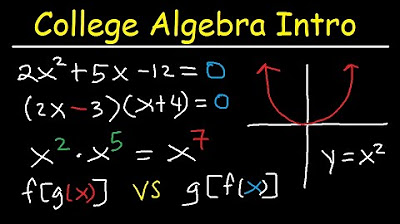Introduction to Linear Algebra: Systems of Linear Equations
TLDRThe video introduces linear algebra, explaining that it involves linear equations which model many real-world relationships despite their simplicity. After covering terminology, it visually depicts solving systems of linear equations geometrically in two and three dimensions. With more variables and equations, new techniques are needed, so a key focus going forward is to learn tools like matrix notation to solve more complex and practical systems of linear equations.
Takeaways
- 😀 Linear algebra involves studying systems of linear equations, which have widespread real-world applications
- 👍 Linear equations represent a balance of simplicity and complexity that makes them useful for modeling real relationships
- 📈 We can construct systems with any number of linear equations and variables; solving them involves finding values to satisfy all equations
- 🎯 Key tools we'll use are matrix notation and various techniques to solve systems of linear equations
- 😎 Linear systems can have no solutions, one solution, or infinite solutions depending on the equations
- 📊 We can visualize simple linear systems geometrically, but more complex ones transcend our spatial reasoning
- 🤔 The more equations and variables in a system, the more complicated it is to conceive and solve
- 🧮 Consistent systems have at least one solution; inconsistent ones have no solutions
- 🥛 A simple applied example involves optimizing purchase of milk and orange juice given budget constraints
- 👍🏻 Understanding linear algebra concepts deeply will allow us to solve more meaningful real-world problems
Q & A
What is linear algebra based on?
-Linear algebra is based on very simple concepts like lines, but expands on these concepts to arrive at fundamental truths about mathematics.
What form do linear equations take?
-Linear equations take the form Y = MX + B, where Y is the output, M is the slope, X is the input variable, and B is the y-intercept.
Why are linear equations useful for modeling real-world relationships?
-Many real-world relationships demonstrate linearity, making linear equations a good balance of simplicity and complexity for modeling such phenomena.
What makes up a system of linear equations?
-A system of linear equations consists of two or more linear equations with two or more variables that need to be solved simultaneously.
How do we solve a simple system of two linear equations graphically?
-We can graph each equation as a line and find the point where the two lines intersect, which represents the solution to the system.
How can systems with more variables and equations be visualized?
-With three variables, the equations can be represented as planes intersecting at a point. More than three variables transcends our geometric visualization abilities.
When does a system of equations have no solution?
-When the equations describe parallel hyperplanes, there is no intersection point, yielding no solution to the system.
What is a consistent system?
-A consistent system has at least one solution. Parallel lines or planes represent an inconsistent system with no solutions.
What is matrix notation?
-Matrix notation is a mathematical tool we will use to help solve systems of linear equations.
What is the dimension of a solution to a linear system?
-The dimension of a solution matches the number of variables in the system.
Outlines
😊 Introducing Linear Algebra
This paragraph introduces linear algebra, explaining that it involves the study of linear equations which are useful for modeling real-world relationships. It discusses the ubiquity of linear equations due to their balance of simplicity and complexity. Examples of linear equations with multiple variables are provided, showing how they can be used to solve problems with constraints.
📝 Defining Terminology for Linear Equations
This paragraph formally defines what constitutes a linear equation for the purposes of linear algebra. Specifically, a linear equation has multiple terms consisting of a coefficient multiplied by a variable, with the variables not raised to exponents nor appearing in products/quotients. Systems of linear equations with multiple variables and equations are also introduced.
👩🏫 Using Matrices to Solve Linear Systems
This closing paragraph notes that a key tool for solving systems of linear equations in linear algebra is matrix notation. It segues into the next video which will cover matrices.
Mindmap
Keywords
💡linear equation
💡system of linear equations
💡solution to a linear system
💡consistent system
💡inconsistent system
💡matrix
💡coefficient
💡variable
💡term
💡dimension
Highlights
Linear equations have a lot of real-world applications, since so many things have linear relationships
Linear equations are right in the middle - not too simple, not too complicated, which actually end up modeling a lot of real-world relationships
We can choose any value for one variable and then calculate the other based on the linear equations
As more parameters are added, things get more complicated, but each equation remains linear
A solution to a system of linear equations will have as many values as there are variables in the system
When a system has at least one solution, it is consistent; when it has no solutions, it is inconsistent
With 3D systems, the intersection point of 3 planes represents the solution to the system
There can be an entire line or plane as a solution, yielding infinite solutions
Matrix notation will be a key tool for solving linear systems
Real-world applications are more interesting than buying milk and orange juice
Linear equations represent a happy medium of simplicity and complexity
Adding more parameters creates more options and complexity
Consistency of a system relates to having solutions
Geometric representations only work up to 3 dimensions
Tools like matrices help solve higher dimensional systems
Transcripts
Browse More Related Video

College Algebra Introduction Review - Basic Overview, Study Guide, Examples & Practice Problems

PROBLEMS INVOLVING SYSTEM OF NONLINEAR EQUATIONS || PRECALCULUS

Matrices to solve a system of equations | Matrices | Precalculus | Khan Academy

Elimination Method For Solving Systems of Linear Equations Using Addition and Multiplication, Algebr

1. The Geometry of Linear Equations

Algebra - How To Solve Equations Quickly!
5.0 / 5 (0 votes)
Thanks for rating: